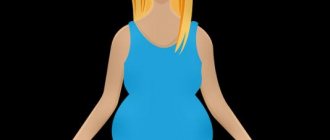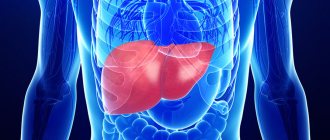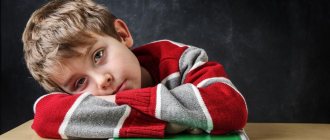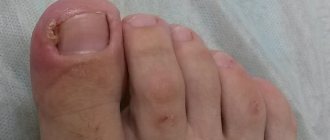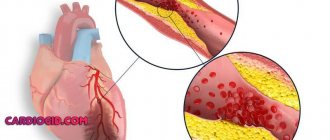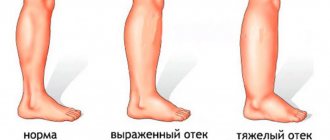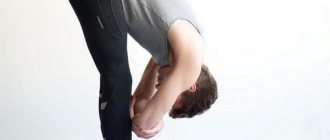The circulatory system is necessary to fully saturate all cells of the body with nutrients and oxygen. The return movement of blood to the heart is called venous outflow. When this process is disrupted, the return of valuable fluid from the central nervous system to the heart muscle fails. In such a situation, the doctor diagnoses “venous dysgemia.” All “waste” blood moves back through the veins, so in a situation where any obstacles arise in its path, stagnation begins to appear. In places of inhibition, the blood gradually destroys the walls of the veins, trying to find new paths for its movement. If we examine the circulatory system as a whole, then its arterial component is structured almost the same in all people, but the venous part differs, sometimes significantly.
Causes of pathology
There are three locations of stagnation, so venous dyshemia has three types:
- the problem originated in the brain;
- in the plexus of vertebrae;
- in the ECA basin area.
The main reason for the development of pathology is hereditary predisposition. The disease manifests itself as dysfunction of the cardiovascular system or musculoskeletal system; problems in bone joints with cartilage are likely. This type of disease can manifest itself even in newborns.
The most recent studies confirm that in children the disease more often appears due to the structural features of the cervical spine. This is usually a special curvature or tortuosity of the bone canal. The problem may be congenital or provoked by a birth injury in the area of 1–2 vertebrae in the neck. In such a situation, treatment is necessarily aimed at completely restoring the integrity and functions of the bones of this section, guaranteeing correction of the child’s posture.
Types and classification
It has three main subspecies:
- dyshemia of the central brain;
- vertebral plexuses;
- dyshemia of the ICA basin.
The classification of the disease has 3 stages of development.
- Latent. Not accompanied by severe symptoms. A person does not observe deviations and does not suspect the development of such a pathology.
- Cerebrovenous discirculation. Symptoms appear, but do not affect the person’s normal life.
- Venous encephalopathy. Clinical manifestations cause discomfort to the patient. It is at this stage that pathology is usually diagnosed.
In addition, the disease is determined by its form of development. The primary form is accompanied by circulatory disorders that arise due to changes in venous tone.
The stagnant form is accompanied by the following symptoms: problems with blood outflow from the brain of mechanical etiology. In this case, surgical intervention cannot be avoided.
Diseases that can provoke the development of pathology
There are a number of diseases that can provoke the appearance of venous dysgemia in a child:
- Stenosis. A characteristic phenomenon of pathology is vasoconstriction, due to which the veins gradually begin to collapse. As a result, the natural process of blood outflow is disrupted, and vein blockage develops. It is incredibly difficult to identify the problem, since narrowing of blood vessels by less than half does not give any unpleasant symptoms.
- Deformation of organs that impede normal blood flow, pinching of valves or bridges. In such a situation, the direction of blood flow may be changed. It happens that a child is already born with an abnormal structure of the venous system - complete or partial closure of blood vessels.
- Even diseases completely unrelated to the blood flow can provoke venous dysgemia - problems in the spine, the presence of cancerous tumors, or previous trauma suffered by the child.
- Not the last place on the list is occupied by bad habits - overeating, teenage smoking, drinking alcoholic beverages.
- Osteochondrosis, as well as pathologies of the thyroid gland, are not the cause of improper venous outflow. These problems become a consequence of such a problem.
Symptoms of venous dysgemia sometimes appear immediately after the baby is born due to problems that appear during the perinatal period of fetal development.
Mechanism of disease development and localization
The difficulty may be due to the influence of physiological factors:
- when straining;
- chronic cough;
- singing;
- playing wind musical instruments;
- tilting the head during exercise;
- incorrect position of the head and neck during sleep.
The mechanism of development of the disorder is associated with a violation of the outflow of blood from the brain when the main, extracranial, and intracranial pathways are damaged. Also if stagnation occurs in the small circulation. The pathology is localized in any part of the brain.
Symptoms
The first and main sign of a problem is the occurrence of acute pain where the blood outflow is blocked. Such points can be easily identified through palpation on the chest, neck, shoulders and head. Painful discomfort is caused by the fact that stagnant blood gradually destroys the tissues surrounding it, trying to “break through” the road.
Children's venous dysgemia is often accompanied by dizziness and spontaneous headaches. The baby often has a fever, causing a sharp increase in temperature. In an advanced state, the severity of symptoms is much more serious, it is manifested by the following parameters:
- violation of natural coordination of movement;
- dysfunction of the main sensory organs;
- performing involuntary movements;
- development of complete or partial paralysis;
- convulsions;
- nosebleeds;
- constant sensations of pain;
- impaired motor skills, slurred speech.
At the very beginning of the development of the disease, it practically does not manifest itself at all. Only sometimes the child complains of short-term impairment of motor coordination and headaches. In addition, venous problems cause metabolic disorders and lack of oxygen. These disruptions provoke constant chills, surges in blood pressure, and the limbs periodically go numb.
Tension headaches in children
Academician of the Russian Academy of Medical Sciences, Professor Ivashkin V.T.: – We very smoothly moved from acute or stress insomnia to tension headaches in children, since Andrei Sergeevich Petrukhin had already introduced himself in the discussion. Please, Andrey Sergeevich.
Professor Petrukhin A.S.: – It must be said that there are three problems regarding headaches in children, despite the fact that in the 21st century neurology has achieved such success that, unlike those sciences that existed before, which said that the etiology is unknown, the pathogenesis is unclear, and there is no specific treatment. Now in neurology, almost one hundred percent diagnosis can be established using various research methods. But there remain three problems that are vague. They are still unclear and very difficult to diagnose and understand. And in particular these are headaches, dizziness and tics. There is a lot that is still unclear here. And it must be said that the headaches section is a section that is not based on any physical research methods, most often visualization ones. They serve, rather, to exclude and confirm the symptomatic nature of headaches. That is, a disease is, say, a brain tumor or an aneurysm, which manifests itself as headaches. Here we are now taking this section - only pure headaches.
In general, pain in children occurs in a special way. And there is an ancient Greek saying that pain is the watchdog of health. But our outstanding scientist, a physiologist who studied pain, said the following phrase: health lies in the physiological muteness of the internal organs. Here’s from Romain Rolland: “An adult, when he suffers, can reduce his pain by mentally placing it in a certain part of his body, as if fencing himself off from it, defining boundaries. But the child does not have this deceptive means. His first encounter with pain is more tragic and deeper. It seems to him limitless, like his very existence.” Therefore, headaches, one can only imagine what kind of suffering a child is often exposed to.
And this slide shows those pains that do not have any pathological influence and which are normally observed in children. These are stomach pains. These are “growing” pains in the bones, when a child cries and complains in the morning, he, as a rule, even points with his hand to the zones of the metaphysis of the bones, the transition zones, where the bone growth zone is: this is the ankle, under the knee. These are pains that go away with growth and do not require any treatment. And 15-20% of headaches are also physiological. They occur because the growth and lengthening of blood vessels is not consistent. Such hemodynamic age-related physiological changes occur. There is no need to attach importance to this and they, as a rule, go away with age and do not require specific treatment. But it must be said that, of course, when a child complains, one cannot help but attach importance to this, because the child does not have social experience, so he cannot feign any pain. Especially frequent headaches reduce his quality of life, affect mental and physical abilities, and disrupt relationships with adults and peers.
And headache (definition) is pain and discomfort localized in the head area. These sensations are always subjective. Therefore, anamnesis plays a very important role in diagnosing headaches, a very detailed anamnesis: when it occurs, where it occurs in the head, how long they last, with what intensity.
Here is the international classification of headaches. These include migraines, tension headaches, cluster (or cluster) headaches, that is, chronic paroxysmal hemicrania, and this also includes Horton's syndrome, which subsequently leads to narrowing of the palpebral fissure, development of blepharophimosis, and constant lacrimation. And various headaches not associated with structural damage, but associated either with trauma, vascular disorders, intracranial processes, not of a vascular nature, for example, the residual phenomenon of some inflammatory processes; associated with the use of chemicals or psychoactive substances, which is very important now, because you can fight and fight, and then in the end you find out that the child smokes marijuana or takes drugs that cause headaches. Headaches associated with metabolic disorders. And facial pain due to pathologies of the skull, neck, eyes, ears, paranasal sinuses, from teeth or diseases of the oral cavity or other structures of the face and skull. As well as cranial neuralgia, pain in the nerve trunks and referred headaches. This is what we mean called the Ged or Zakharyin-Ged zone. And Zakharyin described it, and for the first time the English doctor Ged described it. And he wasn't even a doctor. He was a physiologist. For liver disease, this is the crown; for the lower lobe of the lungs, this is the parietal region. Such hyperpathic sensations in the head. Well, there are in other structures.
Here the reasons are shown, and note that the primary headache is 92%, of which 54% are tension headaches. And migraine takes up 38%. Migraine, as a rule, is, firstly, a hereditary disease. It is transmitted through the maternal line; as a rule, the headache is more intense for the mother and is usually more intense for the son. And the phenomenon of anticipation is also present, although migraine is not a disease of gene expansion. But the earlier and stronger the headaches, the earlier and more severe the headaches occur in the child. And boys suffer more.
And among schoolchildren aged 7-16 years, 39% of children complain of headaches, and 52% are children aged 10 to 12 years. And migraine is observed in 21%, and tension headaches - almost 80%.
Headaches are caused by irritation of intracranial or extracranial receptors, sensory branches of the cranial nerves and the first three cervical roots of the spinal cord. The pathogenesis is different. Extracranial pain receptors are located in the skin, subcutaneous tissues, muscles, tendons, tendon helmet (in the aponeurosis), vessels of the soft integument of the head, in the periosteum of the skull, the oral and nasal cavities, and the muscles of the nose and middle ear. And intracranial receptors are located, firstly, in the membranes. The brain itself is painless, you can scoop it out with a spoon and it does not respond in any way. There were even cases during the war of wounded people picking out their brains with their fingers. Well, the dura mater, and the sinuses especially, are equipped with very dense pain receptors. And also the arteries themselves, like the heart; by the way, the muscle itself is painless during a heart attack, but the vessel hurts. And these pains are caused by irritation of vascular receptors in the meningeal arteries, in the dura mater of the sickle and tentorium. Especially in the area of the tentorium: there are terrible headaches, and, as a rule, they are combined with meningeal symptoms: neck muscle tension, Kernig’s sign, and so on.
Here, much attention is paid to complaints: the duration of occurrence, frequency, localization, irradiation (where these pains spread, where they radiate), nature, duration, beginning and end, provocation, precursors, accompanying symptoms, the presence of chronic diseases. For migraines, for example, there are very important provoking factors. These are the smells of perfume or tobacco, or certain floral smells. Frequency: it is paroxysmal, develops extensively, that is, from low to peak, and ends, as a rule, with vomiting. And vomiting brings relief, by the way. Consciousness, intelligence, mood, blood pressure, muscle tension (pericranial, upper shoulder girdle), neurological edema, presence of meningeal or focal symptoms. For example, with Horton's syndrome (tufted), it is important to identify swelling and hyperesthesia of the skin. And with tension headaches, this is tension in the scalp muscles associated with mood.
Therefore, the first and still considered classical approaches for the treatment of tension headaches are approaches with the prescription of antidepressants, because this is often combined with depression and mood disorders. Therefore, they often occur in women. But among children - girls suffer more often - they are very responsible ones, who are waiting for some kind of trouble, a catch, failure in answering at school, who are bullied by their peers, which is repeated. And for some reason this system is misanthropic in our country. Once upon a time it developed in schools and the class struggle degenerated into a struggle with each other. Now we have a very difficult situation at school. And we will have to approach this at some point. And here additional methods, as I told you, they cannot determine what kind of headache it is. They can only allow us to exclude tumors: this is when there is swelling in the fundus, vasodilation, venous stagnation. X-ray of the paranasal sinuses can reveal an inflammatory disease. Blood tests suggest that this headache may be a symptom of rheumatic or some other process, and CT and magnetic resonance imaging can detect some intracranial processes, tumors, and can also detect vascular and malformations.
And so I had a completely wild case. I gave a forensic medical report on the medical history. In one of the regions close to Moscow, where a girl was treated for headaches for a long time and was even diagnosed with epilepsy, which was not the case, and she died suddenly at home. Moreover, she had a heart defect. And, of course, this disturbance of blood circulation, disturbance of blood oxygenation, of course, led to the occurrence of chronic headaches. Therefore, a pediatrician must know neurology, at least the basics, and a neurologist must know the basics of pediatrics.
Clinical manifestation of headaches. The child is less active, capricious, easily irritable, puts his head on the sofa, on his side in bed. Forced position of the head means you need to think more about the tumor. Children often hold their hand on the sore spot, clearly show the place where the headache hurts and stroke the corresponding part of the head, pull their hair, and if you touch the hair yourself, you can find points of hyperesthesia. Older children keep their heads still; instead of turning their heads, they turn their whole body, with their whole body. And now children from two years old even indicate where their head hurts, and children from 6-7 years old describe the sensations in detail.
And here are the phenomena of headaches in young children according to Hurthl. This is facial expressions: a serious facial expression, eyebrows knitted, a bitten or twisted mouth. Pantomime: trembling or unusual position of the head, pressing on a sore spot, biting a finger, lip, grinding teeth. Vegetative symptom: pallor or redness of the face, cold fingers, cold sweat, goose bumps. Also auditory: persistent screaming, crying, sobbing and suppressed coughing. And in particular behavior: decreased activity and interests, increased irritability, aggressiveness and loss of appetite. Vomiting can occur in children.
Migraine - I have already said - is a paroxysmal condition, manifested by attacks, mainly in the orbital-fronto-temporal region, or less often bilateral localization: in the forehead and occiput. Attacks of vomiting, accompanied by nausea, photophobia. The recurrence of the attack and hereditary predisposition are characteristic.
Migraine - the prevalence is 12-15% of the population, children under six years old suffer from migraine in one percent of cases, at the age of 10-12 years - 4.5%, and from 15 years old - 5.3%. Up to the age of six, it is more common in boys, at the age of 7-11 equally in both boys and girls, and after 18 years in boys, attacks regress and long-term remissions are noted.
Tension headaches are actually the topic we moved on to. Occurs in children in 70-80% of all cases of headache. Emotional stress associated with studying, excessive workload with additional activities, uncomfortable work place, eye strain, family conflicts, excessive parental care, lack of physical activity or excessive physical activity. These pains can usually occur after a long period of stress. Here the pathogenetic feature is the immaturity of the child’s psychological defense mechanisms, which causes the appearance of the disease under minor, from the point of view of adults, stress. Tension headaches often occur in children who are shy, dissatisfied with themselves, and poorly adapt to a new environment. They experience outbursts of stubbornness and whims, which are in the nature of defensive reactions against the background of dissatisfaction with themselves.
For some reason, the parents themselves don’t work ten jobs, but in our country it’s typical that a child has to play music, sports, take additional foreign language classes, and sit another eight hours at school. And they don’t get any smarter. I haven’t seen either the Pushkins or the Dostoevskys lately.
Recently, such works have appeared - and there are already quite a large number of them - on the role of magnesium in the pathogenesis of tension headaches. Magnesium is an intracellular ion that is not observed in free form. Therefore it is very difficult to research. And low magnesium levels are important in the pathogenesis of headaches, as well as seizures in newborns. Low serum magnesium levels are observed in patients with tension headaches and migraines in the interictal period. Studies have reported the positive effects of magnesium supplementation in patients with different types of headaches. Well, this is an article that shows the role magnesium plays in muscle tone and helmet tension. Here are the types of tension headaches: infrequent episodic, frequent episodic, chronic headaches with tension of the pericranial muscles and chronic headaches without tension of the pericranial muscles.
Tension headaches in children are characterized by: bilateral pain in the frontotemporal or frontoparietal regions, sometimes with a feeling of pressure on the eyes. The pain can be constricting, squeezing, like a helmet, pressing in nature, and not intensify from physical activity. Associated symptoms: sound fear, photophobia, nausea, increased pain when touching the scalp and hair, sleep disturbance. They stop on their own or when falling asleep. Children after seven years old can talk about their feelings. With long-term chronic tension headaches, if girls run in high-heeled shoes, they feel a sensation in the head, because prolonged tension of the scalp causes a violation of the venous outflow from the cranial cavity and then such dyshemia occurs - this is an overflow of the venous sinuses, and then are also head receptors. And such a severe headache appears.
For headaches, magnesium preparations are used and can be used as ex juvantibus therapy, because magnesium cannot be overdosed. The more you introduce it, it will simply be eliminated; it will no longer enter the cell. And vitamins, also non-steroidal anti-inflammatory drugs; in more severe cases and chronic headaches, magnesium preparations are combined with psychotropic drugs, such as the anti-anxiety drug atarax; and antidepressants, usually recently; Well, tricyclics can be used, but they are still a bit heavy. And we have a big problem with serotonin reuptake inhibitors, because of all of them, perhaps, only Zoloft is approved for children over the age of six. And in younger children it is even worse that we cannot use these drugs, so it is recommended (today the previous lecturer was asked a question) here is Teralen, French. Unfortunately, we don’t supply it in drops, apparently because it’s very cheap. And Teraligen is difficult to dose because it comes in tablets. Phenibut is also a drug, the only nootropic drug that reduces tone and which calms. And the combination is also with bellataminal, an ancient drug. There is no need to joke or smile here. The fact is that belladonna, according to the principle of evidence-based medicine, is one of the few drugs that, according to the criteria of evidence-based medicine, work effectively.
Well, dosage forms of magnesium. There are ampoules and tablets that contain 470 milligrams of magnesium lactate in each tablet. And there are also ampoules of magnesium citrate, magnesium citrate is also available in tablets, containing approximately 100 milligrams of magnesium.
Non-drug treatment of headaches. It is very important not only to examine the child, but also to find out the family situation. As with tics and tension headaches, especially find out what the situation is in the family. Of course, the parents won’t tell, and we can’t be in their house to find out what the situation is like there. This is the principle of such declarative education: where did you sit, why did you stand up, why are you standing like that, not like that. The child cannot answer, but internally he is all collected and tense from such boorish and rude upbringing. And it has long been noticed that the declarative principle of education is absolutely ineffective. An example of our society is that for 73 years we were educated in party committees, we went through the school of Marxism and Leninism. As soon as it happened, everyone immediately ran away and everyone forgot about communism. Eliminating family traumatic factors is the first important step that must be taken, because you can treat with medications as much as you like, but if there is an abnormal environment at home, there will be no effective therapy. Maintaining a daily routine with sufficient sleep, walks in the air, a combination of mental work with physical activity, water procedures, a contrast shower after school, a warm shower, a bath, swimming in the pool, reducing time spent watching TV and computer games, which also lead to excessive mental stress .
Diagnostics
It is impossible to prescribe the correct treatment for a patient without conducting a full examination to identify the main causes that provoked the appearance of the pathology. Nowadays, many methods have been developed, there is modern equipment that allows you to almost accurately determine that a child has venous dysgemia. The most effective method is Doppler ultrasound (USD).
It is usually quite difficult to immediately make an accurate diagnosis. Parents should first visit a neurologist, especially when the baby is constantly crying or has nervous behavior.
Even after clarifying the nature of the disease, it is still not easy to develop precise treatment tactics that would eliminate not the pathology itself, but at least its main symptoms. Because of this, doctors hesitate to make a diagnosis, because the problem that has arisen is a consequence of a certain disease that must be eliminated first of all.
Signs
Obvious signs of venous discirculation are varied. They are in many ways similar to other ailments and often worsen in the morning:
- Dull pain in the head.
- Feeling of lethargy and weakness, a weak body even after proper rest; difficult to get out of bed.
- Deterioration of condition before changes in atmospheric conditions.
- Tingling in different parts of the body.
- Decreased visual acuity, the appearance of spots and floaters in the visual field.
- Swelling of the eyelids.
- Blueness and swelling of the nasolabial triangle.
- When coughing, flushing of the facial skin may develop.
- Frequent fainting.
- Expansion of the network of blood vessels in the fundus.
- Loss of coordination, dizziness - this is especially common if blood stagnation is localized in the VBB (in the vertebrobasilar region).
- Epileptic seizures.
- Nausea.
- Speech or swallowing may be impaired (if the pathology affects the vertebrobasilar region).
Phytotherapy
When a child has venous dysgemia in the area of the spinal plexuses, the doctor prescribes healing baths. Viburnum berries, sage herbs, chamomile or elderberry are added to the water.
Other recommendations
The baby, when he realizes what is happening to him, needs to be taught to lead an active lifestyle. The harm of certain habits must be explained to him so that he understands that they are dangerous to his life. The child should be taught to play sports.
Running and long walks help overcome venous dysgemia. It is useful to introduce a teenager to yoga. But as the disease progresses, medical consultation is required to help optimize the expected physical activity. It is better not to visit the sauna, since a sharp change in temperature, despite the stimulation of blood flow, negatively affects blood vessels that are weakened by the disease.
Treatment
In the initial stages, it is often possible to do without medications, with the help of additional non-drug interventions. It is possible to prescribe physiotherapeutic procedures, osteopathy, reflexology. The results of treatment are assessed using ultrasound.
But the first step that needs to be taken to treat a violation of venous outflow is to consult a neurologist. In case of serious disorders and complications, treatment begins with drug therapy. Restoration of the nervous system, increased vascular tone, and elimination of vein compression are required. Treatment with medications is carried out in parallel with non-drug treatment. Therefore, in parallel, the patient is prescribed a visit to an osteopath and physiotherapy sessions.
Treatment continues until the problem is resolved. This may take several weeks or months depending on the severity of the disease and the individual characteristics of the body.
